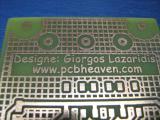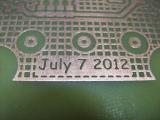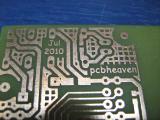PAGE 2 of 9 - The Smartcard Reader board and the PCBs
As i said, the smartcard reader board will not be on the same PCB as the USB On/Off switch board. So, here is the schematic of the reader (subject to future change):
The outputs RC0 and RC1 will be connected to a bi-color LED that will flash red or green if the card is wrong or accepted. I will be using the ICSP PCB pads with the pogo pins connector as explained in my latest article. I kinda liked the way it works!
Pins RC4 through RC7 are used to interface the smartcard reader board with the USB ON/OFF switch board. There will be provided no positive supply, only a common ground. Additionally to this, the collector of the transistor T1 will go to the relay of the USB Switch.
I will use two push buttons for the EEPROM operations. The first button will be used to select Write or Delete mode. When a mode is selected, with the same button you can scroll through the 4 (or more) memory positions. Then, with the other button you can either initialize a Write sequence during which the reader will read and save a new card, or it will initialize a Delete sequence during which the controller will erase this memory position. 4 LEDs (or more) will be used to indicate the memory positions. These LEDs are connected to outputs RD0 through RD3.
Finally, i made a library for the smartcard slot. You can download this eagle library from the following link:
The PCBs
I will not prototype the project on a breadboard, because the USB switch cannot be prototyped on a breadboard successfully (due to high speed signals). So, here are the PCBs that i developed for this project:
You will find the PCB layout for the smarcard in the file i provided above. There are 2 packages, one shows the slot only, and the other shows the slot with a card inserted.
Who wrote these on my PCBs???
Either this is the proof that I've been seeking all those years to prove that ghosts do exist, or I made some very funny mistakes with the PCBs (and i hope that these are the only ones)
 |
 |
 |
| Designe? Yes... Designe... Comes from the English words "Designed" and "Design". Designe is something between these two... |
July 7, 2012, correct... Only one month error... |
July 2010, Damn :/, I missed some 700 days... |
Small pause - More mistakes - Items to come
I'm not quite sure what happened with me when i was designing these PCBs... Maybe the government indeed spray the people to keep them under control and under limited suppression... Maybe this airplane was above my house on June 6...
Some time ago i ordered some stock-items from Microchip, including the PIC16LF1939 QFN PICs that i use in my latest projects. When i made the order, i made a slight mistake: Instead of the 16F1939, i ordered the 16LF1939. This PIC has only low voltage supply, maximum 3.5 volts, for very low power applications. But the smartcards need 5V supply and outputs 5V signal.
When i designed the PCBs, i forgot to add the proper interface between the PIC and the smartcard, so either i have to re-design the PCBs, or order some more PICs, this time 16F1939... And since i cannot solder anything else before i solder the 11 by 11 mm QFN package, i have to wait some 3-5 days to receive the PICs... Damn :/ :/ :/
Comments
At 25 October 2015, 7:00:24 user Giorgos Lazaridis wrote: [reply @ Giorgos Lazaridis]@Oliver I found this one on ebay
At 22 October 2015, 15:06:45 user Oliver wrote: [reply @ Oliver]Hi,
Where can I buy a smartcard slot? (the one you solder on the PCB)
Regards,
Oliver
At 20 August 2015, 22:08:48 user Giorgos Lazaridis wrote: [reply @ Giorgos Lazaridis]@doug No i do not have them as commercial units. But I do design commercial products for customers. If you wish you can contact me by email and discuss your needs.
At 20 August 2015, 17:39:11 user doug wrote: [reply @ doug]Giorgos, That is great. Are you or anyone commercializing these at all? I would buy 50 right now for a specialized facility I have but not sure I want to build that many myself.....
At 19 August 2015, 21:25:40 user Giorgos Lazaridis wrote: [reply @ Giorgos Lazaridis]@Piyush Pandey I use the photographic transfer method.
At 11 August 2015, 12:01:12 user Piyush Pandey wrote: [reply @ Piyush Pandey]This is a very cool project of yours and I must admit that its a very well documented as well with snapshots wherever required.
But Giorgos I want to know that what is the procedure you followed in making the
PCB as I am greatly impressed the print and cleanliness of the PCB.
At 21 October 2012, 4:54:26 user PCB Assembly wrote: [reply @ PCB Assembly]This was one of the most well documented blog entries I have read in a long time. It was a pleasure to fill all the gaps I had about this topic. Well written an concise.
At 3 September 2012, 21:14:58 user pcb wrote: [reply @ pcb]Thanks for share this pcb layout design work... its give me more better ideas for my future projects...
At 3 September 2012, 21:04:29 user Thanassis Mavrogeorgiadis wrote: [reply @ Thanassis Mavrogeorgiadis]Very good project. Well done George!
At 14 August 2012, 20:56:06 user Giorgos Lazaridis wrote: [reply @ Giorgos Lazaridis]@Pat I see what you mean... I think i will make some tests :D
At 14 August 2012, 20:09:12 user Pat wrote: [reply @ Pat]@Giorgos Lazaridis Yeah, like I said, it'll work... mostly. If you take a look at TPC 12 on the ADG714 datasheet, the frequency response at ~500 MHz is going to be around -8 dB. The maximum attenuation of a USB cable is basically the same as that ( http://www.usb.org/developers/presentations/pres0410/2-2_SSUSB_DevCon_PHY_Heck.pdf ) - so essentially, you've basically just put in a long USB cable.
So long as you're talking about devices that are attached with, say, like a 1' cable or something like that, you won't notice basically anything. It's all just a question of how much margin you have left.
At 14 August 2012, 19:48:27 user Giorgos Lazaridis wrote: [reply @ Giorgos Lazaridis]@Pat this was one of my concerned, it works ok until now, and i have test usb devices like external HDD (which i copied some 300GB of data with no problem) and also my camcorder uses the USB for the video. Nevertheless, have order relays with 4p2t if the adg fails or have slow data transmission.
At 14 August 2012, 18:23:49 user playfsx wrote: [reply @ playfsx]molis eida smartcard lock skeytika oti enas apo ellinas eixe kanei kati paromio me tilekartes kai tsoup na se pali :P ! ekseretiki douleia opws panta !
At 14 August 2012, 14:39:43 user Pat wrote: [reply @ Pat]"I'm not sure if the ADG714 can be used for USB applications."
No, it can't. It's the bandwidth that matters, not the on-resistance. It has a bandwidth of 155 MHz, which is way below USB spec. This is because the ADG714's input/output capacitance isn't 6/4 pF: I'm not sure where you got that from (the digital input/output capacitance is 3/4 pF respectively). Its on capacitance is *22* pF. This is way, way too high: on a 50 ohm input that's a critical frequency of ~150 MHz.
Switches designed for USB (like the FSUSB46) have on capacitances more like 4 pF, leading to a bandwidth of well greater than 480 MHz.
This design will work... some of the time. Probably mainly with short USB cables and devices that are well within USB spec. Definitely with low-speed USB devices. But high-speed USB devices could easily struggle since you're probably tacking on at least ~6 dB of attenuation.
At 4 July 2012, 8:01:53 user George Karkalis wrote: [reply @ George Karkalis]Nice app,useful and educational if I may say so! |
|
 HOT in heaven! HOT in heaven!

|
|

 Home
Home
 Projects
Projects
 Experiments
Experiments
 Circuits
Circuits
 Theory
Theory
 BLOG
BLOG
 PIC Tutorials
PIC Tutorials
 Time for Science
Time for Science
 Contact
Contact
 Forum
Forum
 Projects
Projects
 Experiments
Experiments
 Circuits
Circuits
 Theory
Theory
 BLOG
BLOG
 PIC Tutorials
PIC Tutorials
 Time for Science
Time for Science
 RSS
RSS